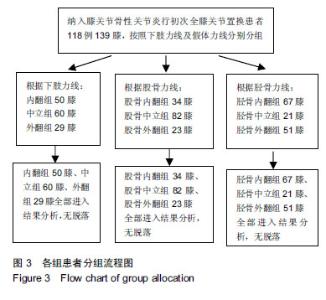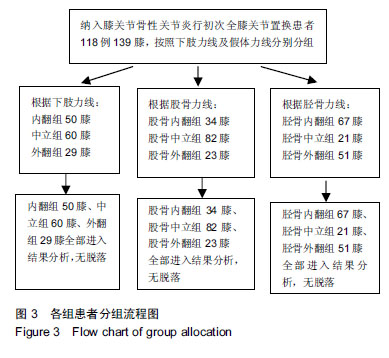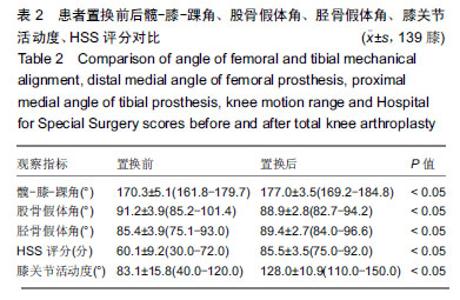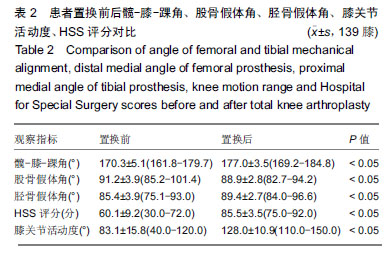Chinese Journal of Tissue Engineering Research ›› 2019, Vol. 23 ›› Issue (24): 3780-3785.doi: 10.3969/j.issn.2095-4344.1288
Previous Articles Next Articles
Relationship of lower limb alignment and component alignment with outcomes and implant loosening rate after total knee arthroplasty
- Department of Orthopedics, Affiliated Hospital of Xuzhou Medical University, Xuzhou 221006, Jiangsu Province, China
-
Online:2019-08-28Published:2019-08-28 -
Contact:Chen Xiangyang, MD, Chief physician, Associate professor, Master’s supervisor, Department of Orthopedics, Affiliated Hospital of Xuzhou Medical University, Xuzhou 221006, Jiangsu Province, China -
About author:Yang Shuo, Master candidate, Department of Orthopedics, Affiliated Hospital of Xuzhou Medical University, Xuzhou 221006, Jiangsu Province, China -
Supported by:the Health Family Planning Commission Project in Jiangsu Province, No. H2017081 (to ZGC); the Jiangsu Youth Medical Talents Project, No. QNRC2016800 (to ZGC)
CLC Number:
Cite this article
Yang Shuo, Feng Shuo, Xu Chongjun, Tang Jinlong, Pei Fang, Zha Guochun, Chen Xiangyang.
share this article
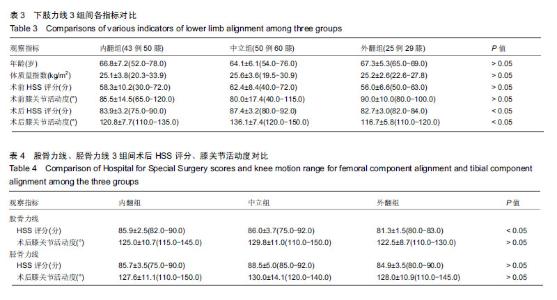
2.4 置换后下肢力线组间比较 对于下肢力线,内翻组50膝,中立组60膝,外翻组29膝。3组间术后HSS评分比较,中立组与内翻组比较(P=0.011),中立组与外翻组比较(P=0.018),差异均有显著性意义,其中中立组评分最高,而内翻组和外翻组比较,差异无显著性意义(P=0.507),见表3。 2.5 置换后股骨假体力线组间比较 对于股骨假体力线,股骨内翻组34膝,股骨中立组82膝,股骨外翻组23膝。股骨内翻组、股骨中立组与股骨外翻组HSS评分比较,差异均有显著性意义,且股骨中立组HSS评分最高;而3组间术后膝关节活动度均无显著差异(P > 0.05),但股骨中立组术后膝关节活动度大于股骨内翻组和股骨外翻组,见表4。 2.6 置换后胫骨假体力线组间比较 对于胫骨假体力线,胫骨内翻组67膝,胫骨中立组21膝,胫骨外翻组51膝。3组间术后HSS评分、膝关节活动度比较差异均无显著性意义(P > 0.05),但胫骨中立组术后HSS评分最高,见表4。 2.7 植入物与宿主的生物相容性 植入物生物相容性良好,3组患者均未出现植入物周围感染、过敏反应、免疫反应及排斥反应。"
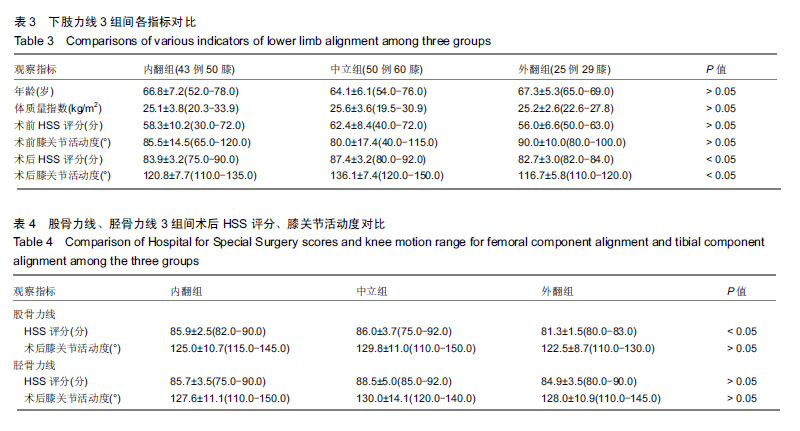
| [1]吕厚山. 人工膝关节置换术的进展和现状[J]. 中华外科杂志, 2004, 42(1):30-33.[2]Ritter MA, Davis KE, Meding JB, et al. The effect of alignment and bmi on failure of total knee replacement. J Bone Joint Surg Am. 2011;93(17):1588-1596.[3]Hungerford DS. Alignment in total knee replacement. Instr Course Lect. 1995;44:455-68. [4]Sharkey PF, Hozack WJ, Rothman RH, et al. Insall Award paper. Why are total knee arthroplasties failing today? Clin Orthop Relat Res. 2002;404(404):7-13.[5]Bellemans J, Colyn W, Vandenneucker H, et al. The chitranjan ranawat award: is neutral mechanical alignment normal for all patients?: the concept of constitutional varus. Clin Orthop Relat Res. 2012;470(1):45.[6]Vanlommel L, Vanlommel J, Claes S, et al. Slight undercorrection following total knee arthroplasty results in superior clinical outcomes in varus knees. Knee Sur Sports Traumatol Arthrosc. 2013;21(10): 2325-2330. [7]Ritter MA, Faris PM, Keating EM, et al. Postoperative alignment of total knee replacement. Its effect on survival. Clin Orthop Relat Res. 1994;299(299):153.[8]Parratte S, Pagnano MW, Trousdale RT, et al. Effect of postoperative mechanical axis alignment on the fifteen-year survival of modern, cemented total knee replacements. J Bone Joint Surg Am. 2010;92(12):2143.[9]Howell SM, Kuznik K, Hull ML, et al. Results of an initial experience with custom-fit positioning total knee arthroplasty in a series of 48 patients. Orthopedics. 2008;31(9):857-863.[10]Howell SM, Hodapp EE, Vernace JV, et al. Are undesirable contact kinematics minimized after kinematically aligned total knee arthroplasty? An intersurgeon analysis of consecutive patients. Knee Surg Sports Traumatol Arthrosc. 2013; 21(10):2281-2287.[11]Ramadier JO, Buard JE, Lortatjacob A, et al. Radiological assessment of knee deformity in the frontal plane (author's transl). Rev Chir Orthop Reparatrice Appar Mot. 1982;68(1):75-78.[12]Ewald FC. The Knee Society total knee arthroplasty roentgenographic evaluation and scoring system. Clin Orthop Relat Res. 1989;248(248):9-12.[13]Longstaff LM, Sloan K, Stamp N, et al. Good alignment after total knee arthroplasty leads to faster rehabilitation and better function. J Arthroplasty. 2009;24(4):570-578.[14]Puliero B, Favreau H, Eichler D, et al. Total knee arthroplasty in patients with varus deformities greater than ten degrees: survival analysis at a mean ten year follow-up. Int Orthop. 2019;43(2):333-341. [15]Matziolis G, Adam J, Perka C. Varus malalignment has no influence on clinical outcome in midterm follow-up after total knee replacement. Arch Orthop Trauma Surg. 2010;130(12):1487-1491.[16]Magnussen RA, Weppe F, Demey G, et al. Residual varus alignment does not compromise results of tkas in patients with preoperative varus. Clin Orthop Relat Res. 2011;469(12): 3443-3450.[17]Shetty GM, Mullaji A, Bhayde S, et al. Factors contributing to inherent varus alignment of lower limb in normal Asian adults: role of tibial plateau inclination. Knee. 2014;21(2):544-548.[18]Delport H, Labey L, Innocenti B, et al. Restoration of constitutional alignment in TKA leads to more physiological strains in the collateral ligaments. Knee Surg Sports Traumatol Arthrosc. 2015; 23(8):2159-2169.[19]Slevin O, Amsler F, Hirschmann MT. No correlation between coronal alignment of total knee arthroplasty and clinical outcomes: a prospective clinical study using 3D-CT. Knee Surg Sports Traumatol Arthrosc. 2016;25(12):1-9.[20]Fang DM , Ritter MA , Davis KE. Coronal alignment in total knee arthroplasty: just how important is it? J Arthroplasty. 2009; 24(6-supp-S):39-43.[21]Saragaglia D, Sigwalt L, Refaie R, et al. Influence of the post-operative axis on the clinical results of total knee replacement for severe varus deformities: does a slight residual varus improve the results? Int Orthop. 2018. doi: 10.1007/s00264-018-4092-7.[22]Huang TW, Lee CY, Lin SJ, et al. The influence of alignment on midterm outcome after total knee arthroplasty in patients with marked coronal femoral bowing. J Arthroplasty. 2015;30(9): 1531-1536.[23]Konan S, Howell S, Oussedik S. Alignment Targets in Total Knee Arthroplasty//Total Knee Arthroplasty. 2015.[24]Saragaglia D, Sigwalt L, Gaillot J, et al. Results with eight and a half years average follow-up on two hundred and eight e-Motion FP® knee prostheses, fitted using computer navigation for knee osteoarthritis in patients with over ten degrees genu varum. Int Orthop. 2018;42(4):799-804.[25]Vandekerckhove PJ, Lanting B, Bellemans J, et al. The current role of coronal plane alignment in Total Knee Arthroplasty in a preoperative varus aligned population: an evidence based review. Acta Orthopaedica Belgica. 2016;82(1):129.[26]Abdel MP, Ollivier M, Parratte S, et al. Effect of postoperative mechanical axis alignment on survival and functional outcomes of modern total knee arthroplasties with cement. J Bone Joint Surg. 2018; 100(6):472-478.[27]Kim YH, Park JW, Kim JS, et al. The relationship between the survival of total knee arthroplasty and postoperative coronal, sagittal and rotational alignment of knee prosthesis. Int Orthop. 2014;38(2):379-385.[28]Gromov K, Korchi M, Thomsen MG, et al. What is the optimal alignment of the tibial and femoral components in knee arthroplasty? Acta Orthopaedica.2014; 85(5):480-487.[29]Howell SM, Papadopoulos S, Kuznik K, et al. Does varus alignment adversely affect implant survival and function six years after kinematically aligned total knee arthroplasty? Int Orthop. 2015; 39(11):2117-2124.[30]Ishikawa M, Kuriyama S, Ito H, et al. Kinematic alignment produces near-normal knee motion but increases contact stress after total knee arthroplasty: A case study on a single implant design. Knee. 2015;22(3):206-212. |
| [1] | Wang Jinjun, Deng Zengfa, Liu Kang, He Zhiyong, Yu Xinping, Liang Jianji, Li Chen, Guo Zhouyang. Hemostatic effect and safety of intravenous drip of tranexamic acid combined with topical application of cocktail containing tranexamic acid in total knee arthroplasty [J]. Chinese Journal of Tissue Engineering Research, 2021, 25(9): 1356-1361. |
| [2] | Zhao Zhongyi, Li Yongzhen, Chen Feng, Ji Aiyu. Comparison of total knee arthroplasty and unicompartmental knee arthroplasty in treatment of traumatic osteoarthritis [J]. Chinese Journal of Tissue Engineering Research, 2021, 25(6): 854-859. |
| [3] | Yuan Jun, Yang Jiafu. Hemostatic effect of topical tranexamic acid infiltration in cementless total knee arthroplasty [J]. Chinese Journal of Tissue Engineering Research, 2021, 25(6): 873-877. |
| [4] | Cao Xuhan, Bai Zixing, Sun Chengyi, Yang Yanjun, Sun Weidong. Mechanism of “Ruxiang-Moyao” herbal pair in the treatment of knee osteoarthritis based on network pharmacology [J]. Chinese Journal of Tissue Engineering Research, 2021, 25(5): 746-753. |
| [5] | Li Yonghua, Feng Qiang, Tan Renting, Huang Shifu, Qiu Jinlong, Yin Heng. Molecular mechanism of Eucommia ulmoides active ingredients treating synovitis of knee osteoarthritis: an analysis based on network pharmacology [J]. Chinese Journal of Tissue Engineering Research, 2021, 25(5): 765-771. |
| [6] | Yang Wei, Chen Zehua, Yi Zhiyong, Huang Xudong, Han Qingmin, Zhang Ronghua. Effectiveness of intra-articular injection of hyaluronic acid versus placebo in the treatment of early and mid-stage knee osteoarthritis: a Meta-analysis based on randomized, double-blind, controlled, clinical trials [J]. Chinese Journal of Tissue Engineering Research, 2021, 25(23): 3760-3766. |
| [7] | Deng Zhibo, Li Zhi, Wu Yahong, Mu Yuan, Mu Yuexi, Yin Liangjun. Local infiltration anesthesia versus femoral nerve block for pain control and safety after total knee arthroplasty: a meta-analysis [J]. Chinese Journal of Tissue Engineering Research, 2021, 25(21): 3401-3408. |
| [8] | Mieralimu•Muertizha, Ainiwaerjiang•Damaola, Lin Haishan, Wang Li . Relationship between tibio-femoral mechanical axis deviation on coronal plane and early joint function recovery after total knee arthroplasty [J]. Chinese Journal of Tissue Engineering Research, 2021, 25(21): 3300-3304. |
| [9] | Zheng Kai, Li Rongqun, Sun Houyi, Zhang Weicheng, Li Ning, Zhou Jun, Zhu Feng, Wang Yijun, Xu Yaozeng. Computer-navigated versus conventional one-stage bilateral total knee arthroplasty [J]. Chinese Journal of Tissue Engineering Research, 2021, 25(21): 3305-3312. |
| [10] | Zuo Xiuqin, Yin Sasa, Xie Huimin, Jia Zishan, Zhang Lining. Applicability and specifications of platelet-rich plasma in musculoskeletal repair [J]. Chinese Journal of Tissue Engineering Research, 2021, 25(20): 3239-3245. |
| [11] | Huang Chenyu, Tang Cheng, Wei Bo, Li Jiayi, Li Xuxiang, Zhang Huikang, Xu Yan, Yao Qingqiang, Wang Liming. Application of three-dimensional printing guide plate in total knee arthroplasty for patients with varus and valgus deformity [J]. Chinese Journal of Tissue Engineering Research, 2021, 25(18): 2789-2793. |
| [12] | Li Shangzhi, Zheng Dezhi, Liu Jun. Early analgesia of cocktail therapy after total knee arthroplasty with enhanced recovery after surgery program [J]. Chinese Journal of Tissue Engineering Research, 2021, 25(18): 2794-2798. |
| [13] | Liu Jinlei, Yin Li, Zhang Yi, Wang Haitao, Li Zhuangyan, Xia Peige, Qiao Renqiu. Effects of intravenous tranexamic acid combined with periarticular multipoint injection of tranexamic acid cocktail on blood loss and pain after total knee arthroplasty [J]. Chinese Journal of Tissue Engineering Research, 2021, 25(18): 2833-2839. |
| [14] | Xu Hui, Kang Bingxin, Gao Chenxin, Zhao Chi, Xu Xirui, Sun Songtao, Xie Jun, Xiao Lianbo, Shi Qi. Effectiveness of Tuina in the treatment of pain after total knee arthroplasty in patients with knee osteoarthritis [J]. Chinese Journal of Tissue Engineering Research, 2021, 25(18): 2840-2845. |
| [15] | Deng Bo, Hong Hainan, Fan Yongyong, Cai Guoping, Feng Xingbing, Hong Zhenghua. Efficacy and safety of tourniquet application in total knee arthroplasty and only at the time of cementing: a meta-analysis [J]. Chinese Journal of Tissue Engineering Research, 2021, 25(18): 2908-2914. |
| Viewed | ||||||
|
Full text |
|
|||||
|
Abstract |
|
|||||
